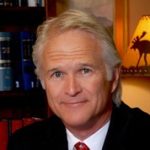In Redd v. DePuy Orthopaedics, Inc., No. 16-3428, (8th Cir., 2017) the United States Court for the Eighth District answered that question.
In 2008 Judith Redd (“Redd”) received a total hip replacement. She was five feet tall, weighed 302 pounds, and took immunosuppressant drugs. These factors placed her at a higher risk for failure of the hip replacement, and in 2012 the implanted hip stem fractured. When it was removed, doctors saw that it had not properly grown into the bone at the top of Redd’s hip. She received a second hip stem implant which similarly fractured less than two years after it was inserted.
Redd sued DePuy Orthopaedics (“DePuy”), the supplier of the initial hip stem implant, asserting negligence and strict liability claims based on product defect and failure to warn. She hired Shankar Sastry, a professor of metallurgy and materials science, to analyze the cause of the fracture. Dr. Sastry had done research in fatigue fracture initiation in metal objects, but not in metal objects implanted in the human body.
After the end of discovery, DePuy moved for summary judgment and to exclude of Dr. Sastry’s testimony. Redd submitted an affidavit from Dr. Sastry testifying that environmental factors would be secondary in the cause of the fracture when the material is inherently defective to begin with. DePuy responded with a motion to strike Dr. Sastry’s affidavit as impermissibly changing his expert opinion after the close of discovery. The district court granted DePuy’s motion to exclude parts of Dr. Sastry’s testimony after concluding that he lacked a scientific or factual basis to conclude that there was a manufacturing defect. The Court said he was qualified to testify about metallurgy. The court said Dr. Sastry had failed to consider the necessary issues of the forces that were exerted on the implant as it was placed in Redd’s hip. It also granted DePuy’s motion to strike Dr. Sastry’s amended affidavit since many of his statements directly contradicted things he said in his deposition and a party cannot change testimony just to avoid summary judgment.
Redd then lacked any expert testimony on defect or causation, and DePuy’s motion for summary judgment on her manufacturing defect claim was granted. Redd argues that the district court erred by excluding Dr. Sastry’s affidavit. This Court will examine if the exclusion of his testimony was abuse of discretion.
A party may not avoid summary judgment by submitting an affidavit that contradicts rather than clarifies previous sworn testimony. Dr. Sastry’s affidavit crossed the line between clarifying prior testimony and changing prior testimony. Given such differences, this Court finds the district court did not abuse its discretion by excluding the affidavit.
Redd also argues that the district court erred by excluding Dr. Sastry’s testimony that her hip stem implant had a manufacturing defect and that defect caused it to fracture. District court judges must ensure that any and all scientific testimony or evidence admitted is not only relevant, but reliable. Here, Dr. Sastry did not consider an obvious alternative explanation for the fracture recognized by Redd’s own doctors: the failure of the hip stem to grow into Redd’s upper hip bone and properly distribute her weight. Although Dr. Sastry testified during his deposition that environmental factors would have been secondary causes of the fracture to the defective material if there had been “small variations in biomechanical forces,” he nonetheless did not consider whether the biomechanical forces applied to Redd’s hip stem had amounted to such small variations (he did not consider the biomechanical forces applied to the hip stem). The district court therefore acted within its discretion by excluding Dr. Sastry’s opinion on causation.
Because of the aforementioned reasons, the District Court’s judgment is affirmed.
The Metier Law Firm is committed to assisting people with personal injury claims throughout Colorado, Wyoming and Nebraska, and we frequently serve as co-counsel to law firms nationwide. Tom Metier recently secured the largest personal injury verdict in Colorado

Nationally recognized litigation attorney Thomas Metier practice areas include traumatic brain injuries, spinal cord injuries, trucking accidents and motor vehicle accidents. He is licensed to practice in Colorado, Wyoming, the U.S. District Court–District of Colorado, and the U.S. District Court–District of Wyoming, the 10th Circuit Court of Appeals and the U.S. Supreme Court.













Comments for this article are closed.